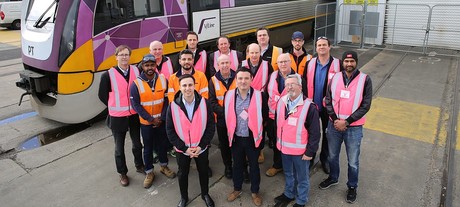Victoria's Regional Rail Connectivity Project

Commuters on Victorian regional rail routes now have almost 100% mobile phone coverage thanks to in-train mobile coverage boosters.
With the average Victorian regional commuter spending up to 20 hours per week aboard regional trains, there has never been a more crucial time to boost the state’s livability by ensuring passengers can stay connected with friends, family and the workplace.
In 2015, the Victorian Government announced it would fix mobile blackspots along Victoria’s five busiest regional rail corridors of Geelong, Ballarat, Bendigo, Traralgon and Seymour, which handle more than 17.9 million passenger trips per year.
Now nearing completion, the $18 million Regional Rail Connectivity Project has seen the installation of Australia’s first in-train mobile coverage boosters. Coverage for Optus, Telstra and Vodafone customers has already improved from less than 50% to almost full coverage as a result of this new technology.
The project is sponsored by the Department of Economic Development, Jobs, Transport and Resources (DEDJTR) and delivered by VicTrack through two key phases (pilot and series rollout) in partnership with V/Line, CommScope, Bombardier, Telstra, Optus and Vodafone.
The in-train solution deployed in V/Line VLocity three-car train sets boasts:
- Roof-mounted antenna that receives the external signal and transmits it to the repeater.
- CommScope Node AM repeater and filter fitted to the centre car, enabling frequencies received by the antenna to be repeated and transmitted into the train cabin.
- Coaxial/radiating cable (‘leaky feeder’) and inter-car connectors. The single repeater services the entire three-car set; leaky feeder functionality is enabled across the three cars via specially designed inter-car connectors that can be detached should the three-car set require separation (eg, for maintenance or repairs).
After the detailed design and successful installation of the in-train equipment, a pilot train travelled from Southern Cross station to Geelong and was able to maintain connectivity for most of the journey — a significant improvement — providing positive indications for the feasibility of delivering the technology across the entire VLocity fleet.

The success of the pilot was a result of aligning stakeholder priorities in determining the location of the repeater within the train and developing the associated technical solutions. This included ensuring commuter space and comfort was not disrupted, ensuring ease of installation of the equipment, as well as enabling stable and continued functionality of the system.
The solution was placed in the roof space of the train, providing a dry and temperature-controlled environment. A unique chassis with pivot arms enables technicians to safely access the overhead repeater, providing an innovative solution for key ergonomics and safety considerations.
Shock and vibration tests were conducted to ensure stability of the unit on a moving train as well as assurance of the equipment’s longevity.
From pilot to operations
The successful pilot meant a quick transition to the rollout phase, which saw the entire VLocity train fleet equipped with mobile boosters by early September 2018. This was a six-month process, which involved the exceptional coordination of resources and technical skill sets of all involved.
As with any large-scale project or rollout of new technology, significant planning in the early stages was a key contributing factor to its success. Thorough technical risk assessments were conducted, with mitigation measures put in place to ensure project continuation. Members of the development team had a solutions-focused mindset, enabling technical advice to be conveyed in the context of ongoing collaboration.
VicTrack and Telstra will continue to work together to maintain the mobile booster equipment for a minimum of 10 years. Following this period, a reassessment will be executed in conjunction with the Victorian Government to determine future needs.
Key considerations will include analysis of the current technology at the time, and whether any updates or modernisation of the system will be required to offer the best connectivity solution.

The 10-year Operation and Maintenance (O&M) period has been agreed on and the entire in-train solution will be supported until at least 2028. Telstra as the design lead, in partnership with Optus and Vodafone, will offer its 4G services to the public.
Telstra remotely monitors and manages the system and VicTrack provides in-field support. This process is driven by integrating a fault management system from Telstra’s Global Operations Centre into VicTrack’s Network Management Centre. To achieve this in-field support, VicTrack has trained wireless technicians in maintaining the in-train repeaters to enable a quick turnaround should any faults be detected.
Passengers can report any problems to their respective mobile phone carrier as they would in any other location in Australia. CommScope, as the original equipment manufacturer and technology partner, will also provide support during the 10-year O&M period.
Coverage for the three participating mobile carriers will continue to be enhanced over the coming months as 35 new mobile towers are installed to complement the mobile booster solution.
The Regional Rail Connectivity Project is a great example of the private and public sectors working together to achieve the best possible result to the benefit of commuters across regional Victoria.
Please follow us and share on Twitter and Facebook. You can also subscribe for FREE to our weekly newsletter and bimonthly magazine.
New technique to eliminate signals disrupting radio telescopes
An unexpected television signal traced to an aeroplane has led to a new method for pinpointing...
5G: the foundation for connected mobility
5G is the driving force behind safe and connected mobility, transforming the future of vehicles...
Hybrid connectivity for mining: keeping OT systems mobile and reliable
Hybrid connectivity solutions are emerging as the future of mining communications, ensuring that...





